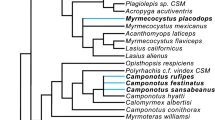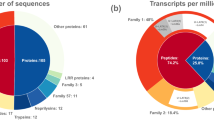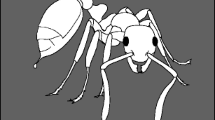Abstract
It is rare to find a true predator that repeatedly and routinely kills prey larger than itself. A solitary specialised ant-eating spider of the genus Zodarion can capture a relatively giant prey. We studied the trophic niche of this spider species and investigated its adaptations (behavioural and venomic) that are used to capture ants. We found that the spider captures mainly polymorphic Messor arenarius ants. Adult female spiders captured large morphs while tiny juveniles captured smaller morphs, yet in both cases ants were giant in comparison with spider size. All specimens used an effective prey capture strategy that protected them from ant retaliation. Juvenile and adult spiders were able to paralyse their prey using a single bite. The venom glands of adults were more than 50 times larger than those of juvenile spiders, but the paralysis latency of juveniles was 1.5 times longer. This suggests that this spider species possesses very potent venom already at the juvenile stage. Comparison of the venom composition between juvenile and adult spiders did not reveal significant differences. We discovered here that specialised capture combined with very effective venom enables the capture of giant prey.






Similar content being viewed by others
References
Aviles L, Tufino P (1998) Colony size and individual fitness in the social spider Anelosimus eximius. Am Nat 152:403–418
Balgooyen TC (1976) Behaviour and ecology of the American Kestrel (Falco sparverius L.) in the Sierra Nevada of California. Univ Calif Publ Zool 103:1–83
Bulbert MW, Herberstein ME, Cassis G (2014) Assassin bug requires dangerous ant prey to bite first. Current Biol 24(6):R220–R221
Cárdenas M, Jiroš P, Pekár S (2012) Selective olfactory attention of a specialised predator to intraspecific chemical signals of its prey. Naturwissenschaften 99(8):597–605
Coddington JA, Levi HW (1991) Systematics and evolution of spiders (Araneae). Annu Rev Ecol Syst 22:565–592
Dejean A, Leroy C, Corbara B, Céréghino R, Orivel J, Boulay R (2010) Arboreal ants use the “Velcro ® principle” to capture very large prey. PLoS One 5(6):e11331
Duda TF Jr, Lee T (2009) Isolation and population divergence of a widespread Indo-West Pacific marine gastropod at Easter Island. Mar Biol 156(6):1193–1202
Dufton MJ (1992) Venomous mammals. Pharmacol Ther 53:199–215
Eberhard WG (1980) The natural history and behavior of the bolas spider Mastophora dizzydeani sp. n. (Araneidae). Psyche 87(3–4):143–169
Enders F (1975) The influence of hunting manner on prey size, particularly in spiders with long attack distance (Araneidae, Linyphiidae, and Salticidae). Am Nat 109:737–763
Escoubas P, Célérier ML, Nakajima T (1997) High-performance liquid chromatography matrix-assisted laser desorption/ionization time-of-flight mass spectrometry peptide fingerprinting of tarantula venoms in the genus Brachypelma: chemotaxonomic and biochemical applications. Rapid Commun Mass Spectrom 11:1891–1899
Franklin CE (1988) Behavioural observations and neurophysiological responses of cockroaches envenomated with Latrodectus katipo venom. Comp Biochem Physiol C 89:117–120
Gregorič M, Agnarsson I, Blackledge TA, Kuntner M (2011) Darwin’s bark spider: giant prey in a giant orb webs (Caerostris darwini, Araneae: Araneidae)? J Arachnol 39:287–295
Griffiths D (1980) Foraging costs and relative prey size. Am Nat 116:743–752
Harland DP, Jackson RR (2006) A knife in the back: use of prey-specific attack tactics by araneophagic jumping spiders (Araneae: Salticidae). J Zool 269:285–290
Herzig V, Ward RJ, Dos Santos WF (2004) Ontogenetic changes in Phoneutria nigriventer (Araneae, Ctenidae) spider venom. Toxicon 44: 635-640.
Hölldobler B, Wilson EO (1990) The ants. Springer, Berlin
Jackson RR, Li D (2001) Prey capture techniques and prey preferences of Zenodorus durvillei, Z. metallescens and Z. orbiculatus, tropical ant-eating jumping spiders (Araneae: Salticidae) from Australia. NZ J Zool 28:299–341
Kozlov SA, Vassilevski AA, Feofanov AV, Surovoy AY, Karpunin DV, Grishin E (2006) Latarcins, antimicrobial and cytolytic peptides from the venom of the spider Lachesana tarabaevi (Zodariidae) that exemplify biomolecular diversity. J Biol Chem 281(30):20983–20992
Kruuk H (1972) The spotted Hyena. University of Chicago Press, Chicago
Kuhn-Nentwig L, Stöcklin R, Nentwig W (2011) Venom composition and strategies in spiders. Is everything possible? Adv Insect Physiol 40:1–86
Kuzmenkov AI, Fedorova IM, Vassilevski AA, Grishin EV (2013) Cysteine-rich toxins from Lachesana tarabaevi spider venom with amphiphilic C-terminal segments. Biochim Biophys Acta 1828:724–731
Laemmli UK (1970) Cleavage of structural proteins during the assembly of the head of bacteriophage T4. Nature 227:680–685
Lazar I (2010) Gel Analyzer software. Available at http://www.gelanalyzer.com/
Lepš J, Šmilauer P (2003) Multivariate analysis of ecological data using CANOCO. Cambridge University Press, Cambridge
Levy G (1992) The spider genera Palaestina, Trygetus, Zodarion and Ranops (Araneae, Zodariidae) in Israel with annotations on species of the Middle East. Israel J Zool 38:67–110
Li D, Jackson RR, Harland DP (1999) Prey-capture techniques and prey preferences of Aelurillus aeruginosus, A. cognatus and A. kochi, ant-eating jumping spiders (Araneae: Salticidae) from Israel. Isr J Zool 45:341–359
Mackessy SP (2010) Crotalus viridis viridis (Prairie Rattlesnake). Noxious weeds as a hazard to snakes. Herpetol Rev 41(3):363
Martišová M, Bilde T, Pekár S (2009) Sex-specific kleptoparasitic foraging in ant-eating spiders. Anim Behav 78:1115–1118
McCue MD (2005) Enzyme activities and biological functions of snake venoms. Appl Herpetol 2:109–123
Nakazawa T, Ohba S, Ushio M (2013) Predator–prey body size relationships when predators can consume prey larger than themselves. Biol Lett 9:20121193
Nentwig W (1987) The prey of spiders. In: Nentwig W (ed) Ecophysiology of spiders. Springer, Berlin, pp 249–263
Oksanen J, Blanchet FG, Kindt R, Legendre P, Minchin PR, O'Hara RB, Simpson GL, Solymos P, Stevens MHH, Wagner H (2012) Package 'vegan' version 2.0-2
Pekár S (2004) Predatory behavior of two European ant-eating spiders (Araneae, Zodariidae). J Arachnol 32:31–41
Pekár S (2005) Predatory characteristics of ant-eating Zodarion spiders (Araneae: Zodariidae): potential biological control agents. Biol Control 34(2):196–203
Pekár S, Král J, Lubin Y (2005) Natural history and karyotype of some ant-eating zodariid spiders (Araneae: Zodariidae) from Israel. J Arachnol 33(1):50–62
Pekár S, Brabec M (2009) Modern analysis of biological data. 1. Generalised Linear Models in R. Scientia, Praha
Pekár S, Lubin Y (2009) Prey and predatory behaviour of two zodariid spiders (Araneae, Zodariidae). J Arachnol 37(1):118–121
Pekár S, Bilde T, Martišová M (2011) Intersexual trophic niche partitioning in an ant-eating spider (Araneae: Zodariidae). PLoS One 6(1):e14603
R Core Team (2012) R: A language and environment for statistical computing. R Foundation for Statistical Computing, Vienna, Austria. URL http://www.R-project.org/
Rabilloud T, Vaezzadeh AR, Potier N, Lelong C, Leize-Wagner E, Chevallet M (2009) Power and limitations of electrophoretic separations in proteomics strategies. Mass Spectrom Rev 28:816–843
Rash LD, Hodgson WC (2002) Pharmacology and biochemistry of spider venoms. Toxicon 40:225–254
Rohou A, Nield J, Ushkaryov YA (2007) Insecticidal toxins from black widow spider venom. Toxicon 49(4):531–49.
Sasa M (1999) Diet and snake venom evolution: can local selection alone explain intraspecifc venom variation? Toxicon 37:249–252
Schaller GB (1972) The Serengeti lion. University of Chicago Press, Chicago
Shevchenko A, Tomas H, Havlis J, Olsen JV, Mann M (2006) In-gel digestion for mass spectrometric characterization of proteins and proteomes. Nat Protoc 1:2856–2860
Turner M (1979) Diet and feeding phenology of the green lynx spider, Peucetia viridans (Araneae: Oxyopidae). J Arachnol 7(2):149–154
Vassilevski AA, Kozlov SA, Samsonova OV, Egorova NS, Karputin DV, Pluzhnikov KA, Feofanov AV, Grishin EV (2008) Cyto-insectotoxins, a novel class of cytolytic and insecticidal peptides from spider venom. Biochem J 411:687–696
Yip EC, Powers KS, Avilés L (2008) Cooperative capture of large prey solves scaling challenges faced by spider societies. PNAS 105(33):11818–11822
Zeh JA, Zeh DW (1990) Cooperative foraging for large prey by Paratemnus elongatus (Pseudoscorpionida, Atemnidae). J Arachnol 18:307–311
Acknowledgments
We would like to thank Y. Lubin for providing us with a collection permit at the Mashabbim sand dunes. We are grateful to G. Corcobado, M. Guererro, J. Král, L. Mestre, and J. Niedobová for help with spider collection in the field, and to L. Sentenská and D. Fridrichová for help in the laboratory. We would also like to thank C. Komposch for his suggestion for the title of this paper. This work was supported by CEITEC project (CZ.1.05/1.1.00/02.0068), CEITEC open access project (LM2011020), and the grant provided by the Czech Science Foundation. SK was supported by the project of European Science Foundation and Ministry for Education and Youth of the Czech Republic CZ.1.07/2.3.00/30.0040 and “Účelová podpora na specifický vysokoškolský výzkum” provided by Ministry for Education and Youth of the Czech Republic.
Author information
Authors and Affiliations
Corresponding author
Additional information
Communicated by: Sven Thatje
Rights and permissions
About this article
Cite this article
Pekár, S., Šedo, O., Líznarová, E. et al. David and Goliath: potent venom of an ant-eating spider (Araneae) enables capture of a giant prey. Naturwissenschaften 101, 533–540 (2014). https://doi.org/10.1007/s00114-014-1189-8
Received:
Revised:
Accepted:
Published:
Issue Date:
DOI: https://doi.org/10.1007/s00114-014-1189-8




